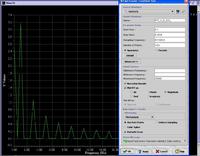Junus2012
Advanced Member level 5

Dear all
I am trying to use the FFT for the first time in my Eldo simulator, I have used a test signal of rectangular signal with Duty cycle=50% and f= 1KHz, after running the FFT I got the attached signal. Also please help me to find the optimum setup of the FFT.
One more question, in signal processing we apply the FFT only on the discrete signal, but here I am using it on a contionous signal as I am thinking that FFT function will sample it. please correct me if I am not right
Thank and looking for your participation

I am trying to use the FFT for the first time in my Eldo simulator, I have used a test signal of rectangular signal with Duty cycle=50% and f= 1KHz, after running the FFT I got the attached signal. Also please help me to find the optimum setup of the FFT.
One more question, in signal processing we apply the FFT only on the discrete signal, but here I am using it on a contionous signal as I am thinking that FFT function will sample it. please correct me if I am not right
Thank and looking for your participation

